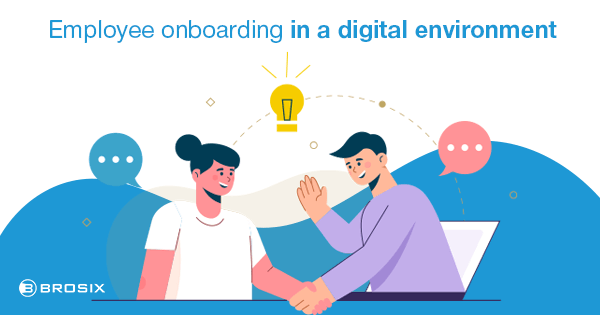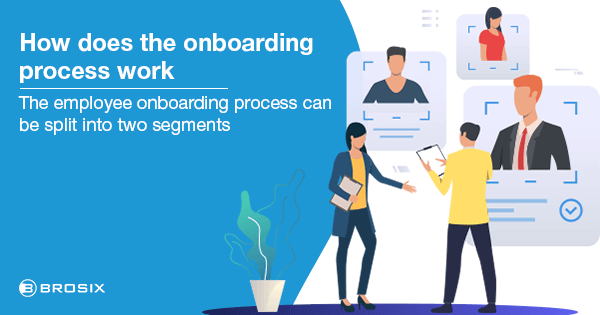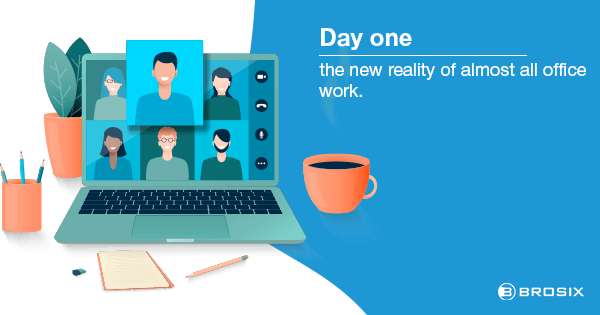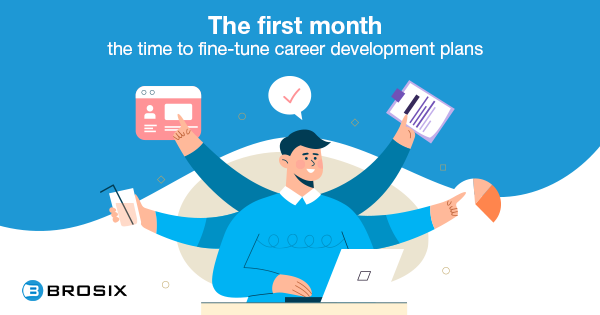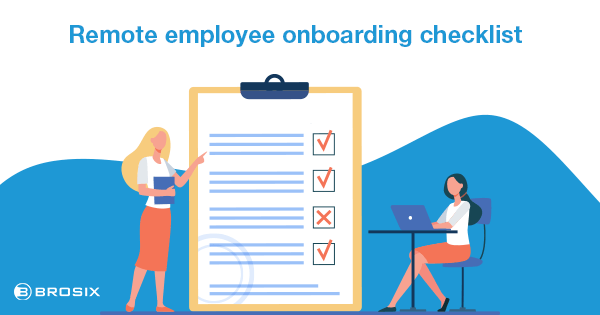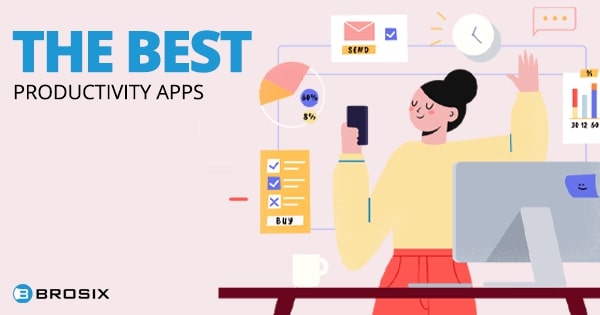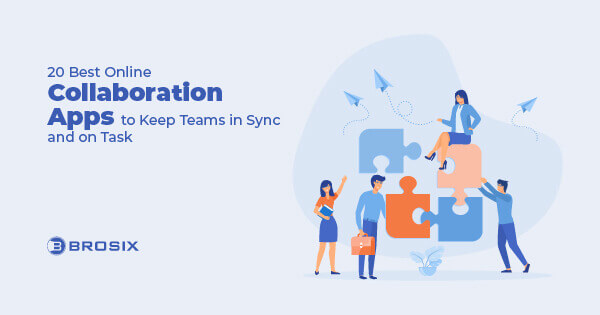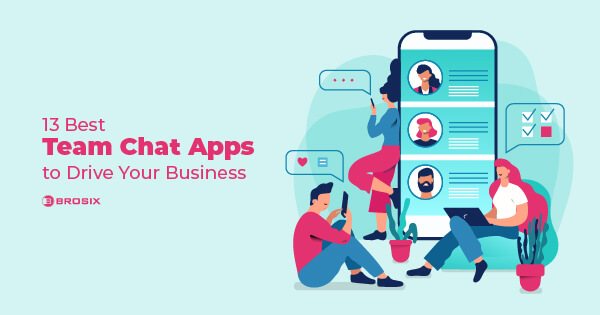COVID-19 and the lockdowns that followed turned our apartments into offices. Many office-based businesses started operating almost exclusively in the virtual space. According to Gartner’s research, the remote workforce in the USA skyrocketed from 30% to more than double during the pandemic.
This means that all HR duties, including new hires’ onboarding process, now have to be conducted online for the foreseeable future.
Since resignation rates have increased during the pandemic, fine-tuning every touchpoint is crucial in order to achieve excellent employee retention.
Employee onboarding in a digital environment
The employee onboarding process is a series of actions that company members engaging with new hires take to improve employee performance, employee retention and acclimation to the company culture. It typically starts with an offer letter sent to prospective new hires and ideally ends on the 90th day or even the first year of their tenure at a company.
Employee onboarding software can dramatically improve the efficacy and efficiency of this process.
Employee onboarding software is a way for the HR team and hiring managers to automate many tasks. When working remotely, this is the only way that the onboarding process can be conducted. On the bright side, it’s the best way to structure the onboarding program to optimize employee retention. Research by the SHRM foundation found that new hires who go through a structured onboarding process have a 69% higher chance of sticking around for up to three years than those who went through the traditional one-week to one-month orientation focused mainly on new-hire paperwork.
Since it involves a lot of online communication, remote onboarding software should accompany an instant messaging app with advanced online security features. Brosix, is a secure HIPAA-compliant instant messaging app for businesses. It ensures that all data transferred with it is encrypted and secure.
Before we learn more about what makes good employee onboarding software, let’s see what the onboarding process looks like.
How does the onboarding process work?
The employee onboarding process can be split into two segments – timeline and implementation.
The timeline segment consists of the things you need to do at the following key stages:
- Moment of sending an offer letter
- Preboarding period
- New employees’ first day at work
- Week one
- The first month
- Three-month period
- Six-months period
- The first year
During these periods, you and the new employee will go through five implementation stages:
- Prep work
- Orientation & training
- Integration
- Engagement
- Follow-up
In-person and remote employee onboarding overlap significantly in this aspect, but we’ll focus on the remote option where they don’t.
Moment of sending an offer letter
At this stage, you’ve already accessed the talent pool and selected your ideal candidate(s). In this “what’s in it for me” period, the one goal you want to achieve when you’re writing an offer letter is full transparency on your part. You will get there by clearly outlining the company policies that are critical for the potential new hires:
- Compensation and benefits
- Vacation and time off
- Scheduling
- Overtime exempt/nonexempt
- Duties
Preboarding – the time to make your presence known
Placed between the moment that the candidate accepts the job offer and their first day at work, it’s the perfect opportunity for you to make a memorable onboarding experience and fend off other companies from poaching your talent. All you need to do is let the new hires know you’re here for them and share information that will get them excited about the latest stage in their careers.
You can kickstart that early sense of belonging by giving them access to their company email, their Brosix account and other platforms they’ll use while at work. Get their future direct managers and coworkers to welcome them to the team via group chat officially.
Also, introduce them to their Buddy – a person that can be their link to the rest of the company and a person for more day-to-day guidance that’s not strictly work-related.
At the same time, you can use this opportunity to start working on the new hire paperwork before the new hire’s official first day. Using Brosix’s peer-to-peer file-sharing technology, sensitive data like social security numbers and passports/personal IDs can be shared safely. As a significant part of new hire orientation, getting this out of the way early on is great.
To prepare them for their first day, week and month, send them their role-specific tasks and assignments.
Finally, share documents, infographics, photos and videos that explain the company’s mission, vision and values (employee handbook, images from team building, anniversaries, company programs and initiatives). Let the new hires get a sense of your company culture early on.
Whatever you decide to do, just be clear that before their first day at work, all participation on their part is considered optional.
Remote preboarding specificity
Remote preboarding on its own is all about the equipment. To avoid any first-day snags, send new employees a checklist of all necessary equipment and instructions on how to test it.
If you are sending any of it, make sure it arrives well before the first day to assess any possible issues on time.
Successful pre-boarding would mean that:
- You haven’t lost a new hire due to a lack of early engagement on your part
- You completed at least some of the orientation tasks before day one
- New hires are already familiar with your expectations regarding their role at the company
- New hires are familiar with your corporate culture
Day one – time for guiding new hires in the right direction
The goal here is to avoid confusion and a sense of overwhelm. Reduce stress levels for new employees by inviting them to arrive a bit later than the working hours suggest. It will make them feel more appreciated and relaxed.
During this period of the onboarding process flow, you as an HR team member should spend the first and the last 30 minutes of the new hires’ workday to welcome and debrief them. Brosix’s video chat feature is an ideal tool for this whilst working remotely, which is the new reality of most office work.
Also, to have a more successful employee onboarding process, focus on the experience, not the paperwork. In other words, make sure it’s relational and not transactional. You can do that by setting clear expectations and responsibilities and supporting the new hires through their onboarding experience.
That’s why on the first day, new hires should make their first meaningful connections and start learning the ropes in both the role-related sense and the casual sense. Sending them the first-day agenda beforehand would help immensely.
Some of the things that you should do on the first day are:
- Introduce them to their role from the technical standpoint (give them access to their company email, Brosix and other apps and platforms necessary for their position)
- Have their payroll account ready
- Introduce them to the key team members for their role
- Introduce them to their Buddy
- Officially start orientation and training
- Organize a virtual coffee break room and introduce new hires to other employees
Orientation and training
Even though orientation and training are ongoing processes and can last for weeks, they kick off on the first day and will make a positive first impression if you handle them correctly.
They are also an opportunity for you to gauge the new hires’ skills and determine what role-specific training will be necessary for them. Also, orientation and training start setting clear expectations for the following periods – the first month, 60 days and 90 days at the company.
Doing this remotely actually offers a lot more flexibility than in an office setting. Going through colocated orientation and training is less effective for the employees that prefer the self-learning approach. In a remote location, a new employee has the flexibility to attend video calls with screen-sharing features or to learn by reading necessary documentation and filling out assessment forms.
You can connect Brosix with Google forms to get notified once the assessment forms have been filled out.
Finally, they are officially introduced to the company culture, its mission, vision and values.
One final tip – keep it light on the paperwork, even if you haven’t done any of it during preboarding. The first day should be as people-centric as possible so spread the boring stuff throughout the first week.
The first week – the future is now
This is the time when new hires should be guided towards their bright future at your company. During their first week, you should introduce them to their career growth timeline that will include regular tasks, KPIs, monthly, quarterly and yearly goals, as well as the stretch goals.
To highlight that growth is possible at your company even early on, introduce them to the latest employee of the month or a coworker in a similar role with the fastest career growth.
With their future right before their eyes, new hires are more likely to start performing at the earlier stages of their tenure at the company and provide you with valuable feedback regarding their career path.
One reminder – don’t be blinded by the new employees’ bright futures so that you fail to recognize their immediate contributions. The first week is the first opportunity to give them well-deserved recognition for a job well done. Make sure managers, mentors and team members take every opportunity to shower new hires with praise.
As manager check-ins should be done weekly, the first week is an important opportunity to ensure that the manager and the new hire start on the right foot. In a remote environment, it would be great if they could do it face-to-face. Pairing the Brosix video chat with the whiteboard feature will help them have a more meaningful interaction because they can share diagrams, graphs and secure files that way.
The first week is where prep work is done and foundations are set for their successful integration into their role and the company culture. Depending on company size, training and orientation might begin and end in the first week.
Don’t forget to layer all of this with the tedious but necessary new hire paperwork. It should be done by the end of the first week.
The first month – the time to fine-tune career development plans
In the first month, the integration process is in full swing and the first signs of employee engagement start to appear.
The first month is where new hires’ performances are assessed by their direct managers and HRs. This is when you can identify progress, skill gaps and the new employees’ preferred learning methods. All of this should be communicated during weekly manager check-ins so that everybody is on the same page.
As your new hire quickly acclimates to the company culture and the perks and rules of the workplace, you will start to see the benefits of the buddy program.
In an office setting, Buddies are instrumental in answering all the location-based questions like the best coffee shops and lunch spots and teaching the new hires dos and don’ts around the kitchen.
In a remote environment, a Buddy is the new hire’s first link to other employees and by the end of the month, their work should be done.
The 90-day milestone – employee engagement benchmark
As the new employees reach the third month at the company, their responsibilities have already increased significantly and so has the value of their input. Ask for their feedback on the work itself, how satisfied they are with their relationship with the rest of the team and the company at large. Finally, ask for their feedback on the onboarding process. They are the ones going through it and will have the best suggestions for improving the process further.
The onboarding process doesn’t end with their feedback, of course. The new hires further assess their peak performances and areas for improvement with their direct managers. It also entails motivating them to take on more responsibilities that lead to further career development.
The grand finale – six and twelve-month periods
New hires’ performance reviews after six months and after a year will show plenty of information about their career growth and the success of your onboarding process.
Complete integration into the role and the company culture should be done by the sixth month. If your onboarding process is successful, new hires should be fully engaged in cross-team efforts and could even start tackling the stretch goals by their first year with you.
Remote employee onboarding checklist
A remote employee onboarding checklist is another tool that can help you streamline the onboarding process. It should cover all the steps from the moment you send the offer to their first year at the company.
It is a reminder for hiring managers, HRs and managers to help them arrive at each touchpoint of new hires’ onboarding process flow.
Some of the critical ingredients of a good remote employee onboarding checklist are:
- Employee’s role in the company
- Goals to be achieved in different periods
- New hire orientation schedule and documentation
- Employee learning style preferences
- Company culture materials
- Manager and HR check-in schedules
- Schedule for meeting with other employees
- List of documents to be provided by the new hire
- List of documents to be provided to the new hire
- List of the equipment supplied by the new hire
- List of the equipment provided to the new hire
Conclusion
A robust onboarding process will embody relational onboarding practices adjusted to the conditions the business operates in and onboarding software that will answer the specific needs of an organization using it.
As it seriously affects employee retention rate, the onboarding process is something you’d want to automate. That is why it’s vital to use HR software capable of streamlining processes you’d otherwise spend hours on.
Make sure to keep all steps of the employees’ onboarding journey personal and also ask for their feedback frequently. Employee onboarding is an ever-developing process and will only get better if you customize and update it properly.
Its importance in a virtual setting is even more significant. Proper employee integration and full engagement can be even more difficult to cultivate in a digital environment, if team members don’t receive training and attention throughout the onboarding process this can negatively impact retention rates.
This is why relying on software that will cover most or all communication matters in a secure digital environment is the key to a successful onboarding process.
FAQs
What is employee onboarding?
Employee onboarding is a process guided by hiring managers, HRs and department managers to help new hires understand clearly the following:
Their role in the company
Their future in the company
Company policies
Company culture, vision, mission and values
Effective employee onboarding helps companies keep their new hires for more extended periods by increasing their job satisfaction and in return, increasing the company’s reputation.
What are the 4 phases of onboarding?
The four phases of onboarding are:
Preboarding phase (the period between offer acceptance and first day at work)
Welcoming stage (first day and first week)
Learning phase (time spent on learning the ropes)
Integration phase (the time it takes for new hires to switch to an integral employee)
In the pre-boarding phase, new hires are getting a glance at the company culture and their role in it. It is a period in which you can spark their engagement early on, leading to higher productivity.
In the welcoming phase, they will learn how the company works on a day-to-day basis; they’ll meet their managers and key team members. At this stage, their understanding of the company culture deepens further.
The learning phase is where their communication with the new hire’s management takes over from the HRs and where new hire integration begins.
The integration phase is when it takes new hires to become fully accustomed to their role in the company and it is when their career path starts to develop significantly.
What are the 5 C’s of onboarding?
The five C’s of onboarding are:
- Compliance
- Clarification
- Culture
- Connection
- Check back
Compliance means that new hires have understood and signed all necessary company policies. It also means that they know how to use the company compliance system.
Clarification means that new employees have understood what the company expects from them in their role.
Culture means that they have understood the company’s inner workings through the Buddy program, employee handbook, and networking daily.
Connection means that the new hires have integrated themselves into the company ecosystem by being properly introduced to their coworkers inside and outside their immediate network.
Check-in means that HRs and managers must proactively communicate with the new employees well past the first week period. The usual check-in frequency is every month.
What should be included in employee onboarding?
The crucial elements of successful employee onboarding are:
- The welcome email from the hiring manager, role-specific manager, team members and the assigned Buddy
- The preboarding essentials: new hire’s access to the company email and relevant platforms, equipment list, paperwork (and a disclaimer that they can do it on the first day)
- Formal introduction to key team members
- Crystal-clear description of role and duties
- First-day briefing and debriefing with the HR
- Lunch or a virtual coffee break for a casual exchange with the new hires
- Clearly outlined career path
- Paperwork (spread evenly across the first week)
- Onboarding surveys
- Monthly performance reviews with management




